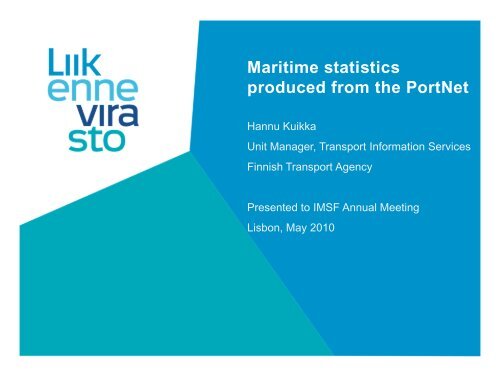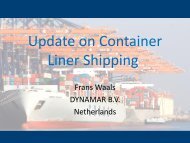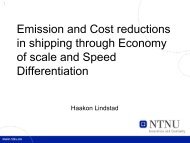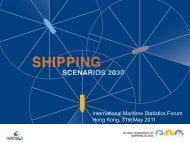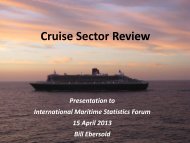PortNet - IMSF
PortNet - IMSF
PortNet - IMSF
Create successful ePaper yourself
Turn your PDF publications into a flip-book with our unique Google optimized e-Paper software.
Maritime statisticsproduced from the <strong>PortNet</strong>Hannu KuikkaUnit Manager, Transport Information ServicesFinnish Transport AgencyPresented to <strong>IMSF</strong> Annual MeetingLisbon, May 2010
Outline• Background information on the Finnish Maritime• Introducing the <strong>PortNet</strong> – Maritime Information System• Maritime statistics produced from the <strong>PortNet</strong>• Future challenges• ConclusionsFinnish Transport Agency
Background information on the Finnish Maritime• Seaborne transports in Finland• Finnish ports• Finnish economy• Organizational reform in 2010concerning all modes of transportFinnish Transport Agency
International transports by sea 1980 – 2009Economic recessionsMillion tons120- 4% in 1995- 19% in 200910080Total604020ImportExport01980 1985 1990 1995 2000 2005 2009Finnish Transport Agency
Background information on the Finnish MaritimeInformation on Finnish portsInformation on Finnish economy• Over 50 operating ports• 23 winter ports that are kept open with theassistance of the icebreakers• Ports are mainly owned by the local publicinstitutions• Port operators are private companiesproviding e.g. stevedoring operations• 40.000 port calls annually• Most of the traffic is international 95 %• The Finnish economy is a small, openeconomy• Exports count nearly 45 % of GDP• Economy is heavily dependent onseaborne transports• 90 % of Exports are carried by sea• 75 % of Imports are carried by sea• Changes in the economy are reflected fastinto the Finnish Maritime• Domestic traffic consists of Inland WaterWay and Coastal traffic 5 %Finnish Transport Agency
Organizational reform concerning all modes oftransport• 2 new organizations were established in 2010- Finnish Transport Agency (Maritime, Road, Railway)- Finnish Transport Safety Agency (Maritime, Road, Railway, Aviation)• The reason for the reform was to implement the EU regulations thatrequired to separate the operative and safety functions• The objective of common agency is to coordinate all modes of transportand to allocate resources more efficientlyFinnish Transport Agency
Introducing the <strong>PortNet</strong> – Maritime Information systemThe idea was to create a comprehensive national Single Window Application for allauthority notices required at ship departures and arrivals to/from all Finnish ports• Background information• Organisations involved with the <strong>PortNet</strong>• Access to the <strong>PortNet</strong>• Special features of the <strong>PortNet</strong>Finnish Transport Agency
Introducing the <strong>PortNet</strong>Background informationOrganisations involved• The national legislation allowed authoritiesto exchange information under certainconditions and to create a common system• First version of <strong>PortNet</strong> was build in 1994for reporting dangerous goods• In 2000 the web based system was created• Today the number of registered user hasincreased to 1.500 and daily users around1.000• Finnish Transport Agency administers theuse of <strong>PortNet</strong>• The <strong>PortNet</strong> was created in a community thatconsisted of Maritime Administration,Customs and 20 biggest ports• <strong>PortNet</strong> is used by Authorities and differentmaritime companies involved in seabornetransportsFinnish Transport Agency
Introducing the <strong>PortNet</strong>Access to PortnetSpecial features of the <strong>PortNet</strong>• Access to the Portnet is restricted• <strong>PortNet</strong> users have different profilesdepending on their status• Timetable information is public but cargoinformation is restricted to authorities, theconcerned ship agents and the port inquestion• Data can be input using the- Web interface- XML file transfer• The large companies are transforming thedata electronically where as the smalleroperators use the web interfaceFinnish Transport Agency
Maritime statistics produced from the<strong>PortNet</strong>• Official Maritime Statistics• Annual Statistics• Monthly Statistics• Eurostat datasetsFinnish Transport Agency
Maritime statistics produced from the<strong>PortNet</strong>Overview on maritime statistics• Official Maritime Statistics are produced from the <strong>PortNet</strong> by the FTA• About 200 ship agents input all the information to the <strong>PortNet</strong> concerning Finnish portcalls, including cargo and passenger data• Maritime statistics are compiled in many different ways according to the user needs- Standard Statistics- Custom Statistics- Data Services• The <strong>PortNet</strong> has improved the quality and efficiency of the statistical processesFinnish Transport Agency
Maritime statistics produced from the <strong>PortNet</strong>Annual and Monthly StatisticsEurostat datasets• Statistics are divided into 2 categories- International Transports 95 %- Domestic Transports (IWW + Coastal) 5 %• Annual Statistics- International Transports- Domestic Transports- Canal Transports• Monthly Statistics- International Transports• Statistics are divided into 2 categories- Sea transports- IWW transports• The required datasets are produced directlyfrom the <strong>PortNet</strong>• The changes in the EU directives arepossible to implement by reprogrammingthe algorithm that produces the datasetsfrom the <strong>PortNet</strong>- Canal TransportsNote: Finnish Transport Safety Agency produces maritime statistics on vessels and seamen from their own systemsFinnish Transport Agency
Maritime statistics produced from the<strong>PortNet</strong>Monthly Statistics on International Shipping• 16 commodity groups covering all Finnish ports• The delay is only about 4 weeks• Published in the internet according to a timetable• Monthly Statistics (preliminary data) includes:- Imports and Exports by type of goods- Imports and Exports by port- Vehicle and container transports by port- Transit traffic by port and by type of goods- Passenger traffic by port and by country- Vessel traffic by port• Monthly Statistics is the most demanded productbecause over 80 % of foreign trade is seaborneFinnish Transport Agency
Future challenges• The creation of a maritimestatistics databank• The harmonization of the statisticswith the Eurostat definitions• The co-operation with the Customs• The political decentralizationprocess in the Public Sector• The Single Voice of MaritimeFinnish Transport Agency
Conclusions• <strong>PortNet</strong> is a prime example of both asingle window application as well asauthority co-operation• Portnet enables to produce a widevariety of maritime statistics rapidly• <strong>PortNet</strong> has common features withthe Eurostat eMaritime-projectFinnish Transport Agency
Thank you for your attention!Hannu KuikkaUnit Manager, Transport Information ServicesFinnish Transport AgencyP.O. Box 33, FI-00521 Helsinki, FinlandMobile: +358 20 637 3944Email: hannu.kuikka(at)fta.fiwww.fta.fiFinnish Transport Agency


